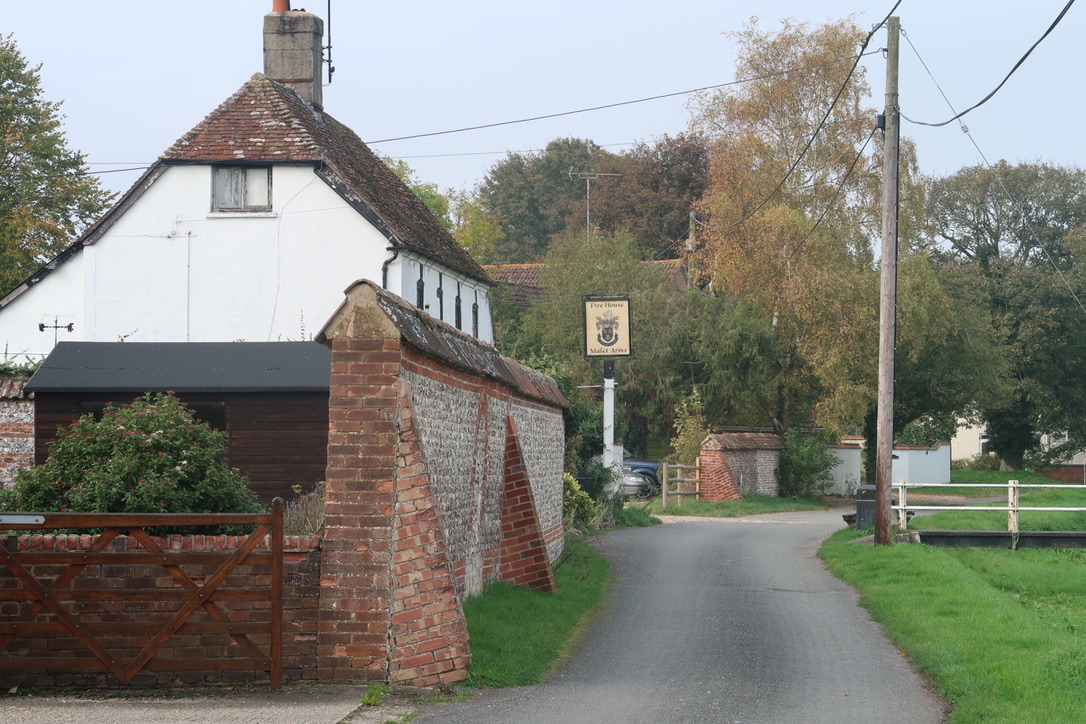
Previously, I have told the story of the extraordinary marriage record of my 3 times grandparents, Thomas Dicks, a cordwainer and the parish clerk of Newton Tony, Wiltshire, and his bride, Caroline Bower, a household servant. Read the full story here:
https://genealogyjude.com/2020/02/01/a-most-extraordinary-marriage-part-1/
Caroline had been born illegitimately and most surprisingly, the rector of Newton Tony had recorded information on both her father and mother in the marriage register:

Wiltshire Council & Swindon Borough Council, Allington 1837-1905, Register of Marriages p.3
At face value, according to the marriage register, both Thomas Dicks and Caroline Bower were 21 years of age in 1843 but the 1851 census of Newton Tony tells a different story:

H.O. 107/1845 244 9 The National Archives UK
In 1851, Thomas Dicks was 44 years older than his wife, Caroline. He was 74 years of age whilst she was a mere 30. Did the marriage register therefore contain a falsehood? Well, not quite. To be married without the consent of parents, one had to be at least 21 years old so in some marriage registers, rather than recording a specific age, couples were described as being of “full age”. A less common alternative to this was to record 21 years as the age: i.e. they were 21 years plus! Thomas was probably rather coy about having his actual age of 66 recorded when he married.
Had Caroline dazzled the lonely widower who had fallen in love with her and asked her to marry him? Despite the considerable age gap, Caroline may have been attracted to marrying a man who had his own business and home. As the parish clerk, (a position he had inherited from his father in 1812 after the latter’s death), Thomas Dicks was a man who was well-respected in the community. Since Caroline was born illegitimately, perhaps her own childhood had been precarious and she was seeking the stability and security that Thomas Dicks could provide.
As can be seen from the 1851 census, Thomas and Caroline Dicks soon had a family together after their marriage in 1843, for by the time the census was taken, their children were Sarah [Ann], (my direct ancestor), aged 7, [Elizabeth] Jane aged 5, Thomas aged 3 and a 3 month old baby, Emma [Eliza]. Caroline’s unmarried sister, Ann Newman, was living with the Dicks family and working as a shoe binder (the job involved stitching the leather together). Also living in the household was James Rogers, a journeyman shoemaker, who was employed by Thomas to help him in his cordwainery business. A cordwainer was highly skilled and made shoes from new leather (as opposed to a cobbler who repaired shoes). James Rogers will become significant later in the story!
In my possession is a charming booklet on Newton Tony, written by a man called William Henry Swift, who had come to live in the village as a boy in the 1870’s. His recollections were published in the Salisbury Journal in 1934, but in 1988, they were collated together and produced in a booklet, illustrated with photographs entitled “A Wiltshire Village in the 1870’s“. He had this to say about the shoemaker in the village, who at this time, was George Armistead, the successor of Thomas Dicks:
If the village bridge was the evening meeting place of the men it was in the shoemaker’s shop that those who had leisure during the day found an opportunity for a gossip. The shop was a thatched outbuilding which had been added to the shoemaker’s cottage. There day after day, with rarely a holiday, he and his son Ted worked, making boots for most of the dwellers in the countryside. I was many times an interested listener to discussions on the politics of the hour or on religious questions between father and son, or with someone who had called about his boots, or to pass an idle hour. These talks were accompanied by the tap-tapping of the hammer on boots in process of making or mending, and were in consequence generally pitched in a high key.”
A Wiltshire Village in the 1870’s by William Henry Swift p. 43
This is a wonderful picture of the shoemaker’s shop being the vibrant heart of village life. Like George Armistead, I can well imagine Thomas Dicks, hard at work in his workshop, tooling the leather skilfully, pausing every once in a while to chat with his customers.
The shoemaker was never short of work. In those days ready-made boot businesses had not yet developed and spread as they have to-day, and the local worker was both a maker and mender of boots. The boots made by our village shoemaker were thoroughly well made; and though perhaps not always the most attractive in appearance, they stood the crucial test of the hard flints on the Wiltshire road. He always made my boots – at eight or nine shillings a pair – and I sometimes sat for hours in the workshop watching them take shape.
A Wiltshire Village in the 1870’s by William Henry Swift p. 43
Bereavement
However, Caroline’s new-found security, and hopefully happiness, was not to last long as maybe inevitably, given Thomas’ age, she was widowed. In 1861, Thomas Dicks died at the age of 84 after fathering a least 7 children from his late 60’s until his death. He was buried in the churchyard of Newton Tony on January 20th 1861:

Wiltshire Council & Swindon Borough Council, Newton Tony 1813-1916, Register of Burials, p33
Just over two months later, Caroline Dicks is recorded in the 1861 census of Newton Tony as a widow, the head of a family of seven young children, the youngest being only a year old. This was a precarious situation to be in, so to support the family, she was doing other people’s laundry, a common means of earning money for widows who had few other options:
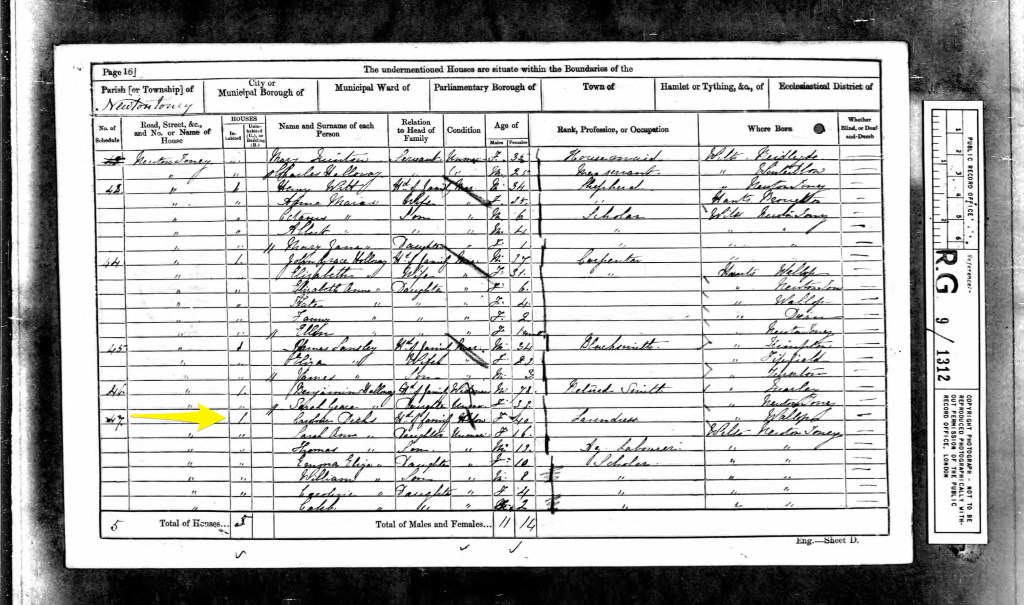
R.G. 9 1312 40/41 16/17 The National Archives UK
Noted living next door to her, by himself and as a separate household, is James Rogers, who was a bachelor and aged 38, born in Amesbury. Although no occupation is recorded, he is clearly the shoemaker who was living and working with Thomas Dicks ten years previously when the 1851 census was taken:
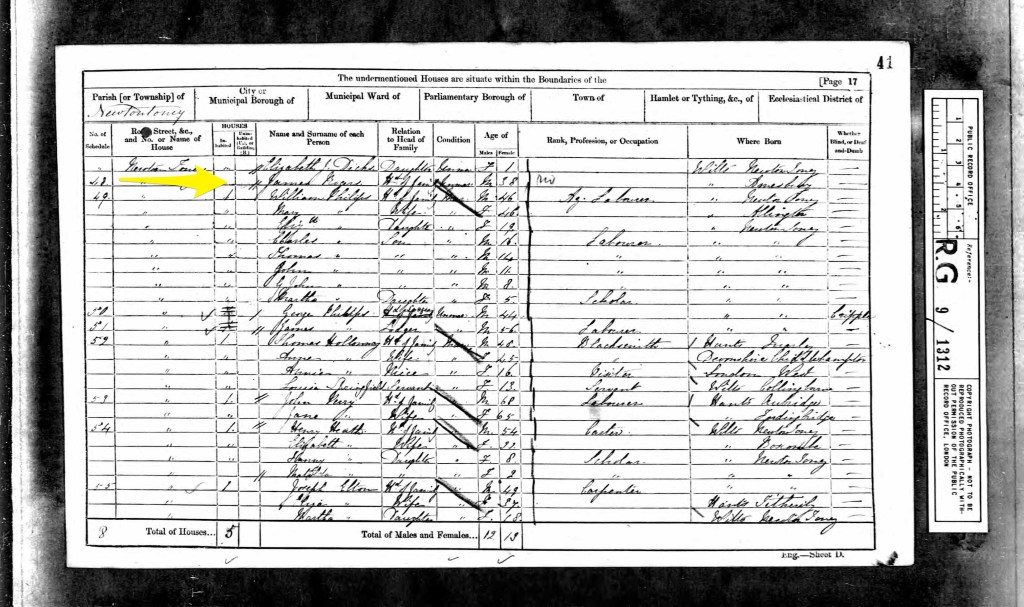
R.G. 9 1312 40/41 16/17 The National Archives UK
The Romance between James Rogers and Caroline Dicks
So what happened to Caroline, the young widow and her children? Later that same year, in 1861, Caroline marries James Rogers. The couple were of a similar age, next door neighbours and since James was the former live-in employee of Caroline’s late husband, they had had the opportunity to get to know each other very well:

Wiltshire Council & Swindon Borough Council, Newton Tony 1837-1916, Register ofMarriages, p 29

In the marriage register, the father of Caroline is named as William Perkins, just as he was when Caroline married Thomas Dicks, but this time, he is described as a sawyer, rather than a labourer. Unlike at the time of her first marriage, there is no information on Caroline’s mother.
James and Caroline Rogers: Their Life in Newton Tony
James Rogers and his wife Caroline went on to have one daughter, Hannah, who is recorded with them in the 1871 census, aged 8, along with Elizabeth, William and Cabit [Caleb], Caroline’s children from her first marriage:

RG10 1946 40 16 The National Archives UK
Elizabeth [Jane] Dicks is described as the daughter in law of James Rogers, whilst the boys, William and Caleb Dicks, are his sons in law. James Rogers was a labourer and clearly had not taken over the business of Thomas Dicks. George Armistead, enumerated on the previous page, was now the village shoemaker and was probably living in the cottage of Thomas Dicks with its adjoining workshop. The birthplace of Caroline is recorded as Broughton, a parish adjoining Nether Wallop, “Wallop” being Caroline’s previously recorded birthplace.
Ten years later, in 1881, Hannah Rogers, the only daughter of James and Caroline, has left home and got married but Caleb, the son of Caroline, is still living in the household and is described as a stepson. James Rogers, his stepfather, has now taken up bricklaying as a job. Visiting the household is Caroline’s daughter, Elizabeth Jane Dicks. She was a servant so probably lived in her place of employment, rather than the family home:

RG 11 2065 32 2 The National Archives UK
In rural areas, it can be difficult to pinpoint the location of a family home as often, no specific address is recorded in census records. I was therefore delighted to find that in “A Wiltshire Village in the 1870’s” there is the following photo with the caption, “Miss Dicks entered domestic service at Wilbury”:

I am confident that the “Miss Dicks” who features in the photograph, in a clean, white pinafore dress, is Caroline’s daughter, Elizabeth Jane Dicks. She was a career servant who later worked in London and never married. Wilbury House, her place of employment at the time, was the seat of the lords of the manor of Newton Tony, the Malet family, who lived there from 1803 until 1925. In 1881 Elizabeth Jane was 35 years old, so perhaps this photograph was taken on one of her visits home around this time.
Last year, I was able to visit Newton Tony and I was delighted to locate the same flint cottage, which is situated close to the church on the main street in the village. The double doors that Elizabeth Jane Dicks is standing in front of, in the original photograph, are still very much in evidence:
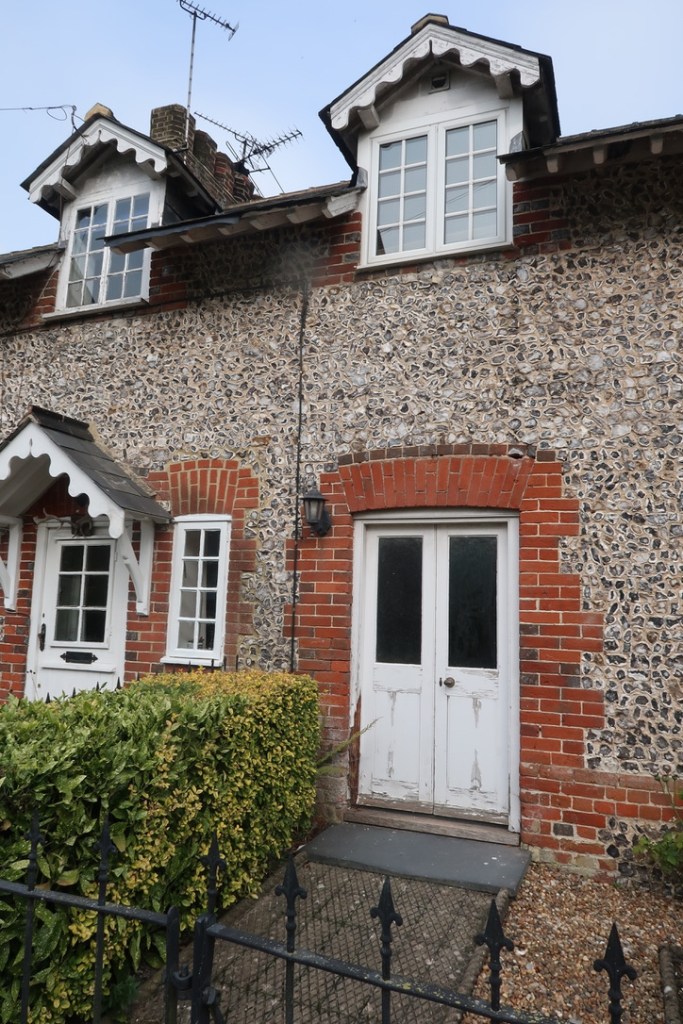

“A Wiltshire Village in the 1870s” also contained a photograph of the cottages with a view towards the church:

The Death of James Rogers
Sadly, Caroline was widowed for a second time when her husband, James Rogers, died in 1888. His burial is recorded in the registers of Newton Tony on 6 October 1888. A few years later, at the time of the 1891 census, Caroline is recorded living in London with the family of her youngest daughter, Hannah Baker, the only child from her marriage with James Rogers:

The Baker family were living in the parish of St George Hanover Square, London. Perhaps Caroline was just visiting, a doting grandmother, eager to meet her new grandson, George, who was a mere three months old. It must have been a big trip for a 70 year old widow from a small Wiltshire country village and a total change of scenery. At this time, there was no station in Newton Tony so to get to London, you had to take a farmer’s cart to either the village of Grateley, three miles away, or Porton, four miles away, which were both on the mainline from Salisbury to London.
Caroline Rogers was now “living on her own means”, which suggests that she had some form of income though she must have been far from being well-off. The Reverend John Newton Peill, the successor of the the Reverend Hugh Price, who had officiated at Caroline’s marriage to her second husband, James Rogers, in 1861, had left £50 in his will to establish a charity to support the poor widows of the parish of Newton Tony, the income being distributed every year on St Andrew’s Day (30th November). Records of the recipients have apparently been kept so it would be interesting to discover if Caroline was amongst them.
A search for Caroline Rogers in the British Newspaper Archive revealed a dramatic moment in her life, when the roof of her thatched cottage caught fire on the night of August 17th 1896:

I imagine that her home was one of the thatched cottages lining the main street of Newton Tony, opposite to the church, made cosy with a wood fire:
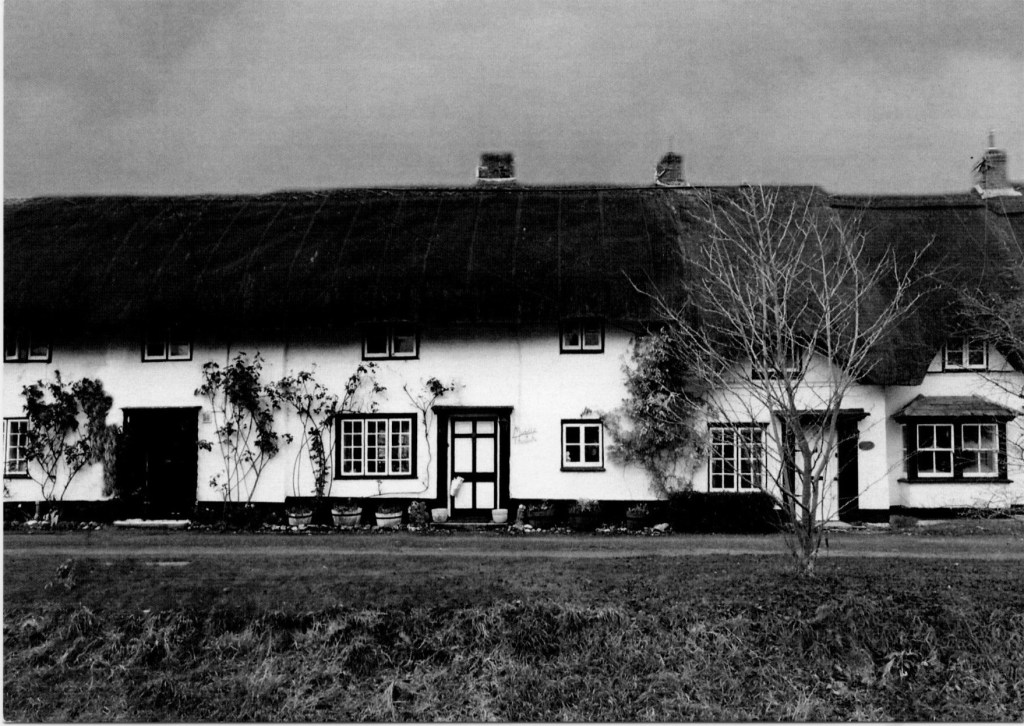
Twilight Years
In 1901, Caroline Rogers is recorded as an 80 year old widow, living in Newton Tony with her 42 year old widowed son, Caleb, and 12 year old granddaughter, Mary. Henry Roberts, aged 19, a blacksmith, was lodging with them, providing extra income for the household:
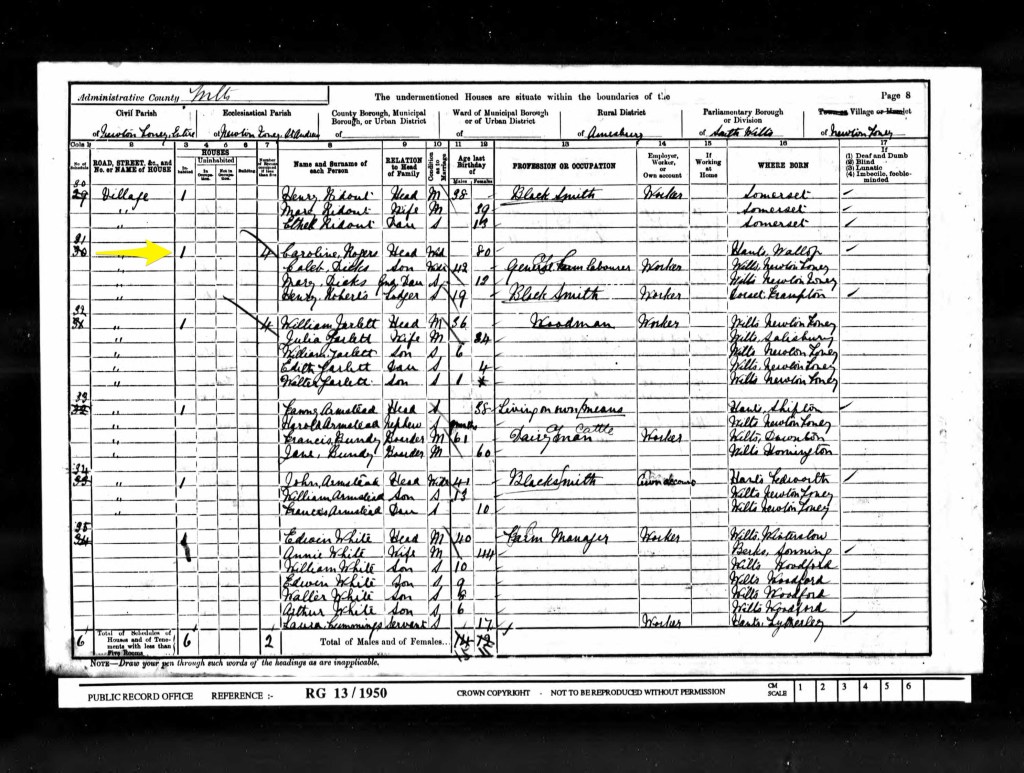
RG 13 1950 8 National Archives UK
A few year later, Caroline Rogers died on November 9th 1904, aged 84, outliving her first husband by 43 years and her second husband by 16 years. She was buried in Newton Tony on November 14th 1904:

Wiltshire Council & Swindon Borough Council, Newton Tony Register of Burials 1813-1916 p.61

(author’s own photo taken October 2019)
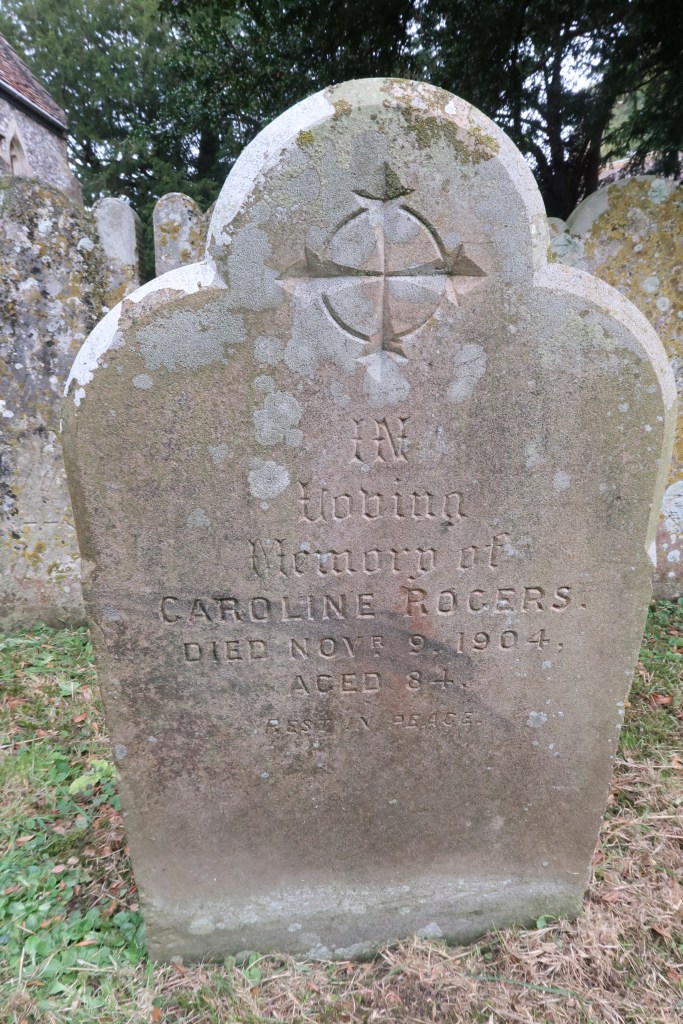
James Rogers is not commemorated on the same stone and after a search of the churchyard, I found his gravestone, covered with lichen, on the opposite side of the church:

It is surprising that James and Caroline Rogers were not commemorated on the same gravestone and indeed, buried far apart from each other in the churchyard. I could find no memorial to Thomas Dicks but I wonder if her children from her first marriage arranged that she was buried close to his resting place.
Postscript
I was galvanised into researching the life of Caroline Bower after being contacted by a DNA match who turned out to be a descendant of Hannah Rogers, the only child Caroline had with her second husband, James Rogers. As a result, I now know a lot more about her life in the small Wiltshire village of Newton Tony.
With regard to her earlier life, the presence of Ann Newman, her unmarried sister, who was living with Caroline’s family when the 1851 census was taken, led me surmise that Maria Bower, Caroline’s mother, had married a Mr Newman. This was confirmed when I found the adult baptism of Ann Maria Newman, the daughter of Joseph and Maria Newman on the 21 September 1846, aged 20, in the parish registers of Newton Tony. Thanks to Clara, a reader of my earlier blog, “An Extraordinary Marriage”, https://genealogyjude.com/2020/02/01/a-most-extraordinary-marriage-part-1/, who had access to Hampshire parish registers on FindmyPast, I now know that Caroline was baptised in the parish of Nether Wallop on 23 July 1820, the daughter of Maria Bower. Maria Bower married Joseph Newman the following year on 19 July 1821 in Nether Wallop. Sadly, Maria died on 22 November 1840 in Broughton at the age of 46 from apoplexy. A coroner’s inquest was held and a tiny notice in the Hampshire Chronicle on 30 November 1840 reveals that she “died suddenly while attending public worship”. Caroline, now a young woman of 19, had to make her own way in the world.
As for William Perkins, the father of Caroline Bower, he spent his life in Nether Wallop, working as a sawyer and carpenter. Recently I have discovered that I have a DNA match with a descendant of one of his sons. It would be interesting to discover if there is additional documentary evidence, such as a surviving bastardy bond, that names him as Caroline’s father.
© Judith Batchelor 2020
A beautifully told story, so well researched and wonderfully written, the image of the Shoemakers Shop evokes memories of a bygone era. The pictures bring the story to life, a truly great read, thank you for sharing.
LikeLiked by 2 people
Hi Judith This is a really fascinating story. You have written it well and it gives an insight into village lives and real people from our family past. Thank you very much for doing this, I really enjoyed it and look forward to your next edition I hope that you are surfing the lockdown and that the children are coping with the isolation form friends and school. It must w be very difficult especially as we have no idea how long this is going to last. I am enjoying the sun and getting the garden into shape. When the sun goes then its time for some more genealogy ! Keep well and stay in touch Love Heather
Sent from my iPad
>
LikeLiked by 1 person
The description of the shoemaker’s shop is so charming! I would never have guessed that the cordwainer’s was the social hub of the village! It really surprises me that Caroline married a man of 73. With all of those children I think it must have been a love match. James was very kind to take on 7 children! I think he must have really loved her as well.
LikeLiked by 1 person
The little book on the village was such a gem in conjuring up every day scenes.
I like to think it was a love match too. I haven’t found any children from the first marriage of Thomas Dicks so he must have felt blessed to have a brood of his own in his old age. You are right, James Rogers deserves a lot of credit too.
LikeLike
Hi again cousin! A great read…. lots of interesting details. You’ve done a fantastic job researching all of this. Kerrie x
LikeLiked by 1 person
Hi Kerrie,
Thanks for your kind comments. I think Caroline Bower had a rather interesting life so it was great fun piecing it together. Jude x
LikeLike